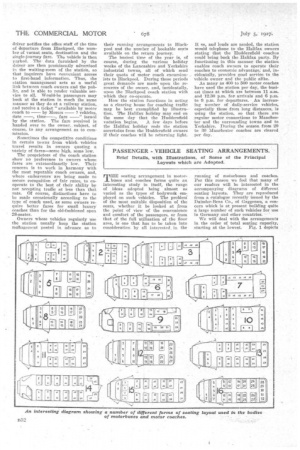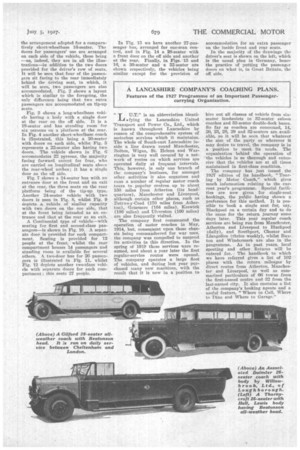PASSENGER — VEHICLE SEATING ARRANGEMENTS.
Page 106

Page 107

If you've noticed an error in this article please click here to report it so we can fix it.
Brief Details, with Illustrations, of Some of the Principal Layouts which are Adopted.
seating arrangement in motor buses and coaches forms quite an interesting study in itself, the range of ideas adopted being almost as varied as the types of bodywork -employed on such vehicles. The problemf of the most suitable disposition of the seats, whether it be looked at from the point of view of the conveniehce and comfort of the passengers, or from that of the full utilization of the foot area, is one that has to be taken into consideration by all interested, in the running of motorbuses and coaches. For this reason we feel that many of our readers will he interested in the accompanying diagrams of different seating layouts. They are reproduced from a catalogue recently issued by the Daimler-Benz Co., of Gaggenau, a concern which is at present building quite a large number of such vehicles for use in Germany and other countries.
We will deal with the arrangements in the order of total seating capacity, starting at the lowest. Fig. 1 depicts
the arrangement adopted for a comparatively short-wheelbase 16-seater. The doors for passengers' use are arranged on each side of the vehicle, these being —as, indeed, they are in all the illustrations—in addition to the two doors provided for the driver's row of seats. It will be seen that four of the passengers sit facing to the rear immediately behind the driving seat, in which, it will be seen, two passengers are also accommodated. Fig. 2 shows a layout which is similar to the foregoing, the only difference being that two extra passengers are accommodated on tip-up seats.
Fig. 3 shows a long-wheelbase vehicle having a body with a single door at the rear on the off side. It is a 19.-seater and has standing room for six persons on a platform at the rear. In Fig. 4 another short-wheelbaSe coach is illustrated, this being a 20-seater with doors on each side, whilst Fig. 5 represents a 22-seater also having two doors. The vehicle shown in Fig. 6 accommodates 22 persons, the majority facing forward except for four, who are carried on longitudinal seats above the rear-wheel arches; it has a single door on the off side.
Fig. 7 shows a 24-seater bus with an entrance door at the front and an exit at the rear, the three seats on the rear platform being of the tip-up type. Another 24-seater vehicle with two doors is seen in Pig. 8, whilst Fig. 9 depicts a vehicle of similar capacity with two doors on the one side, that at the front being intended as an entrance and that at the rear as an exit.
A Continental type of vehicle—with seating for first and second-class passengers—is shown in Pig. 10. A separate door is provided for each compartment. Seating is provided for 12 people at the front, whilst the rear compartment houses 14 passengers and standing room is available for several others. A two-door bus for 26 passengers is illustrated in Fig. 11, whilst Fig. 12 depicts another two-class vehicle with separate doors for each compartment; this seats 27 people. In Fig. 12 we have another 27-passenger bus, arranged for one-man control, and in Fig. 14 a 28-seater with a front door on the off side and another at the rear. Finally, in Figs. 15 and 16, a 30-seater and • a 32-seater are shown respectively, the vehicles being similar except for the provision of
accommodation for an extra passenger on the inside front and rear scats.
In the majority of the drawings the driver's seat is shown on the left, which is the usual plan in Germany, hence the practice of putting the passenger doors on What is, in Great Britain, the off side..












































































































































































